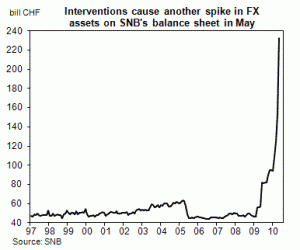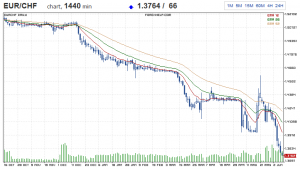According to preliminary data foreign currency reserves at the Swiss National Bank (SNB) in May went up to CHF 232bn from 153bn in April. Meaning they intervened with 4bn per work day in May, up from 1bn previously. And now they wasted half of GDP on potentially worthless currencies (Euros, Dollars).
Why does the SNB not want a strong Swiss Franc? Because for many Swiss companies, a strong CHF hurts their revenues and profits, since they get most of them from abroad (Nestle: 98% of revenue is from outside Switzerland). But the SNB has to be careful. By selling CHF, they in fact create money and hence increase the monetary base. Without creating any assets this might lead to inflation.
On June 4th the SNB was finally forced to stop intervening (they made a last attempt on June 8th – which lasted only a few minutes). The whole episode is very unfortunate, since the SNB so far had not engaged in trying to destroy it’s currency. I understand the difficulty in maintaining a stable exchange rate with it’s biggest trade partners, but if those chose to undermine their currencies (by printing money) the SNB should not feel compelled to do same.
Switzerland has always had very low interest rates (due to low inflation rates – less than 1% annually over the last 10 years). The current inflow on money, presumably moving into Swiss Government bonds, has led to another drop in Swiss 10yr yields to less than 1.5%. Artificially low interest rates can lead to bubbles (i.e. real estate), and, especially coupled with the strong increase in Swiss Francs in circulation (by SNB selling), could endanger stability of the Swiss Economy.
So if the SNB manages to ruin their currency – what’s left?
We will look at gold and silver in a separate post.


